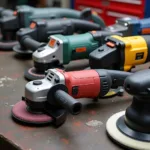Car body repair hydraulic cylinders are essential tools for any auto body shop. They provide the controlled force necessary to straighten damaged vehicle frames and body panels, restoring a vehicle to its pre-accident condition. Understanding their function, types, and proper usage is crucial for effective and safe car body repair.
Understanding the Importance of Car Body Repair Hydraulic Cylinders
Hydraulic cylinders are the workhorses of auto body repair. Their power and precision allow technicians to apply targeted force to reshape mangled metal, making them indispensable for collision repair. These tools are critical for restoring structural integrity and ensuring the vehicle’s safety after an accident. Without hydraulic cylinders, many complex repairs would be impossible, and the quality of repairs would significantly decrease.
Types of Hydraulic Cylinders for Car Body Repair
Several types of hydraulic cylinders cater to various car body repair needs. Single-acting cylinders exert force in one direction, relying on gravity or a spring for retraction. Double-acting cylinders provide force in both directions, offering greater control. Telescopic cylinders extend in stages, providing a longer stroke in a compact design. Porta-power cylinders are versatile and portable, ideal for on-site repairs or accessing difficult-to-reach areas. Choosing the right cylinder depends on the specific repair task, the extent of the damage, and the available workspace.
How to Use a Car Body Repair Hydraulic Cylinder Safely and Effectively
Using a hydraulic cylinder requires careful attention to safety and proper technique. Before beginning any repair, inspect the cylinder for damage, ensure proper fluid levels, and select the appropriate attachments. Secure the vehicle and the cylinder to prevent movement during operation. Apply force gradually, monitoring the metal for signs of stress and stopping regularly to assess progress. Never exceed the cylinder’s rated capacity, and always wear appropriate safety gear.
Choosing the Right Hydraulic Cylinder for the Job
Selecting the correct hydraulic cylinder is crucial for successful car body repair. Consider factors such as the required force, the working stroke length, and the physical constraints of the repair area. For example, a small, compact cylinder is ideal for minor dent removal, while a larger, more powerful cylinder is necessary for frame straightening.
Maintaining Your Hydraulic Cylinders
Regular maintenance is essential to ensure the longevity and performance of your hydraulic cylinders. Inspect hoses and fittings for leaks, check fluid levels, and lubricate moving parts. Proper storage and handling will also help prevent damage and corrosion.
Common Problems and Troubleshooting with Car Body Repair Hydraulic Cylinders
Like any tool, hydraulic cylinders can experience issues. Common problems include leaks, slow operation, and loss of pressure. Troubleshooting these problems often involves checking for fluid leaks, inspecting seals and O-rings, and ensuring proper hydraulic fluid levels.
Why is my hydraulic cylinder leaking?
Leaks can occur from damaged seals, loose fittings, or cracks in the cylinder body. Identifying the source of the leak is crucial for effective repair.
How do I prevent my hydraulic cylinder from rusting?
Proper storage in a dry environment and regular lubrication are essential for preventing rust and corrosion.
“Investing in high-quality hydraulic cylinders and maintaining them properly will save you time and money in the long run. A reliable cylinder is an essential investment for any serious auto body repair shop.” – John Miller, Automotive Engineer
The Future of Hydraulic Cylinders in Car Body Repair
As technology advances, car body repair hydraulic cylinders are becoming more sophisticated. Electronic controls, integrated sensors, and advanced materials are enhancing precision and efficiency. These advancements are streamlining the repair process and improving the quality of repairs.
“The integration of technology with hydraulic cylinders is transforming the car body repair industry. These advancements are enabling technicians to perform more complex repairs with greater accuracy and speed.” – Maria Sanchez, Auto Body Repair Technician
Conclusion
Car body repair hydraulic cylinders are invaluable tools for restoring damaged vehicles. Understanding their various types, proper usage, and maintenance is crucial for any auto body repair professional. By staying informed about the latest advancements and best practices, you can ensure efficient and high-quality repairs. Investing in quality car body repair hydraulic cylinders is a key step in providing excellent service and ensuring customer satisfaction.
FAQ
- What type of hydraulic fluid should I use in my car body repair cylinder?
- How do I determine the correct size hydraulic cylinder for a specific repair?
- What safety precautions should I take when using a car body repair hydraulic cylinder?
- How often should I maintain my hydraulic cylinders?
- What are the signs of a failing hydraulic cylinder?
- Where can I purchase high-quality car body repair hydraulic cylinders?
- How do I dispose of used hydraulic fluid properly?
Need help? Contact us via WhatsApp: +1(641)206-8880, Email: [email protected]. We have a 24/7 customer support team.

